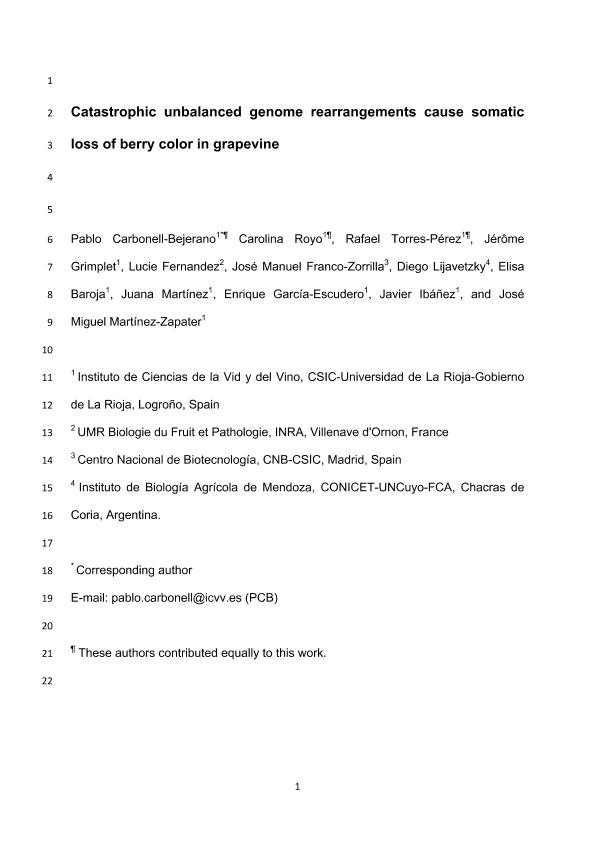Mostrar el registro sencillo del ítem
dc.contributor.author
Carbonell Bejerano, Pablo
dc.contributor.author
Royo, Carolina
dc.contributor.author
Torres Pérez, Rafael
dc.contributor.author
Grimplet, Jerome
dc.contributor.author
Franco Zorrilla, José Manuel
dc.contributor.author
Lijavetzky, Diego Claudio

dc.contributor.author
Baroja, Elisa
dc.contributor.author
Martínez, Juana
dc.contributor.author
García Escudero, Enrique
dc.contributor.author
Ibañez, Javier
dc.contributor.author
Martínez Zapater, José Miguel
dc.date.available
2018-06-19T20:53:56Z
dc.date.issued
2017-08
dc.identifier.citation
Carbonell Bejerano, Pablo; Royo, Carolina; Torres Pérez, Rafael; Grimplet, Jerome; Franco Zorrilla, José Manuel; et al.; Catastrophic unbalanced genome rearrangements cause somatic loss of berry color in grapevine; American Society of Plant Biologist; Plant Physiology; 175; 2; 8-2017
dc.identifier.issn
0032-0889
dc.identifier.uri
http://hdl.handle.net/11336/49475
dc.description.abstract
Grape color somatic variants that can be used to develop new grapevine cultivars occasionally appear associated to deletion events of uncertain origin. To understand the mutational mechanisms generating somatic structural variation in grapevine, we compared the Tempranillo Blanco (TB) white berry somatic variant to its black berry ancestor, Tempranillo Tinto. Whole-genome sequencing (WGS) uncovered a catastrophic genome rearrangement in TB that caused the hemizygous deletion of 313 genes, including the loss of the functional copy for the MYB transcription factors required for anthocyanin pigmentation in the berry skin. Loss of heterozygosity and decreased copy number delimited interspersed monosomic and disomic regions in the right arm of linkage groups (LG) 2 and 5. At least eleven validated clustered breakpoints involving intra- and inter-chromosomal translocations between three LGs flanked the deleted fragments, which, according to segregation analyses, are phased in a single copy of each of the affected chromosomes. These hallmarks along with the lack of homology between breakpoint joins and the randomness of rearranged fragments order and orientation are all consistent with a chromothripsis-like pattern generated after chromosome breakage and illegitimate rejoining. This unbalanced genome reshuffling has additional consequences in reproductive development. In TB, lack of sexual transmission of rearranged chromosomes associates with low gamete viability, which compromises fruit set and decreases fruit production. Our findings show that catastrophic genome rearrangements spontaneously arise and stabilize during plant somatic growth. Despite these dramatic changes may compromise sexual fitness, they generate new interesting phenotypes that can be perpetuated in vegetatively propagated plants.
dc.format
application/pdf
dc.language.iso
eng
dc.publisher
American Society of Plant Biologist

dc.rights
info:eu-repo/semantics/openAccess
dc.rights.uri
https://creativecommons.org/licenses/by-nc-sa/2.5/ar/
dc.subject
Vitis Vinifera
dc.subject
Somatic Mutation
dc.subject
Next Generation Sequencing
dc.subject
Berry Color
dc.subject.classification
Otras Ciencias Biológicas

dc.subject.classification
Ciencias Biológicas

dc.subject.classification
CIENCIAS NATURALES Y EXACTAS

dc.title
Catastrophic unbalanced genome rearrangements cause somatic loss of berry color in grapevine
dc.type
info:eu-repo/semantics/article
dc.type
info:ar-repo/semantics/artículo
dc.type
info:eu-repo/semantics/publishedVersion
dc.date.updated
2018-06-13T16:55:19Z
dc.identifier.eissn
1532-2548
dc.journal.volume
175
dc.journal.number
2
dc.journal.pais
Estados Unidos

dc.journal.ciudad
Rockville
dc.description.fil
Fil: Carbonell Bejerano, Pablo. Universidad de La Rioja. Instituto de Ciencias de la Vid y del Vino; España
dc.description.fil
Fil: Royo, Carolina. Universidad de La Rioja. Instituto de Ciencias de la Vid y del Vino; España
dc.description.fil
Fil: Torres Pérez, Rafael. Universidad de La Rioja. Instituto de Ciencias de la Vid y del Vino; España
dc.description.fil
Fil: Grimplet, Jerome. Universidad de La Rioja. Instituto de Ciencias de la Vid y del Vino; España
dc.description.fil
Fil: Franco Zorrilla, José Manuel. Consejo Superior de Investigaciones Científicas. Centro Nacional de Biotecnología; España
dc.description.fil
Fil: Lijavetzky, Diego Claudio. Consejo Nacional de Investigaciones Científicas y Técnicas. Centro Científico Tecnológico Conicet - Mendoza. Instituto de Biología Agrícola de Mendoza. Universidad Nacional de Cuyo. Facultad de Ciencias Agrarias. Instituto de Biología Agrícola de Mendoza; Argentina
dc.description.fil
Fil: Baroja, Elisa. Universidad de La Rioja. Instituto de Ciencias de la Vid y del Vino; España
dc.description.fil
Fil: Martínez, Juana. Universidad de La Rioja. Instituto de Ciencias de la Vid y del Vino; España
dc.description.fil
Fil: García Escudero, Enrique. Universidad de La Rioja. Instituto de Ciencias de la Vid y del Vino; España
dc.description.fil
Fil: Ibañez, Javier. Universidad de La Rioja. Instituto de Ciencias de la Vid y del Vino; España
dc.description.fil
Fil: Martínez Zapater, José Miguel. Universidad de La Rioja. Instituto de Ciencias de la Vid y del Vino; España
dc.journal.title
Plant Physiology

dc.relation.alternativeid
info:eu-repo/semantics/altIdentifier/url/http://www.plantphysiol.org/content/175/2/786
dc.relation.alternativeid
info:eu-repo/semantics/altIdentifier/doi/https://doi.org/10.1104/pp.17.00715
Archivos asociados
